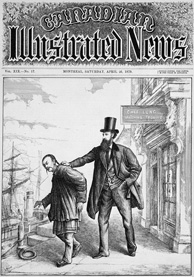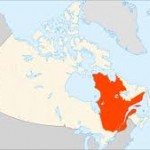Ethnic Violence in Canada or Economic Presevation?
Opposition to Immigration

"A cartoon from the Canadian Illustrated News, 1879, entitled The Heathen Chinee in British Columbia." Source: http://www.collectionscanada.gc.ca (Library and Archives Canada)
Historically, some ethnically motivated violence in Canada has stemmed from xenophobia and fears of economic competition. Notably, throughout the nineteenth century and into the mid-twentieth century there have been recorded incidences of violence against Chinese immigrants (Torrance, 1986).
The Mobilization of Quebec
However, the most notable case of “ethnic violence” in Canada involves the separatist movement of the French-speaking Quebecois. Some groups, such as the Quebec Liberation Front (FLQ) used violent tactics to attract attention to the cause of independence from Canada. While the FLQ certainly gained publicity, the Canadian public considered their approach inappropriate. Meanwhile, the separatist movement sought more peaceful and diplomatic negotiation avenues (Torrance, 1986).
The surge of Quebecois nationalism can be traced to a period of economic prosperity and secularization in province during the 1960s called the “Quiet Revolution.” As with violence against the Chinese, Quebec’s clamoring for independence grew from economic concerns. In this case, the French-speaking population sought independence as a way to preserve the booming economy from “English” interference (Breton, 1988) (also see video above).
These economic goals called for cooperation with Anglo-Canadians and political negotiations rather than violent opposition. War between Quebec and Canada has not been considered. Rather, secession would need to be ratified by more than sixty percent of the population in Quebec (Breton, 1988).
This democratic limitation has also made the threat of the secession of Quebec very real, encouraging compromise between the central government and the province. The trump card of secession has given Quebec significant autonomy in Canada (Dion, 1996).
The Quebecois in Canada and the Kurds in Turkey: A Comparison
Given the language and cultural differences between the French speaking Quebecois and the Anglo-Canadian majority, parallels can be made to the situation of the Kurds in Turkey. The Kurds are also an ethnic and linguistic minority that is fairly geographically self-contained within Turkey. Both groups have at one point pursued violent measures to try to achieve independence.

Kurdish Population in Turkey. Source: csmonitor.com
The geographic similarities (shown above) are also striking. Yet in Canada, the central government entered negotiations with separatists while the government Turkey pursued aggressive assimilation tactics.
Historical considerations could explain why Canadians acted differently from the Turks. Historically, the Kurds have been a displaced group, a population that has been shuffled between countries as a result of conquest and empire dissolution. On the other hand, the French surrendered Quebec to the British in 1759, falling under British administration thereafter (Quebec, 2012). This active handover of power could contribute to the more peaceful historical coexistence of French speakers in Canada compared to the Kurdish in Turkey. As such, aggressive Anglo-assimilation in Quebec has not occurred.
In Turkey however, tensions continue to revolve around more recent historical grievances. The lack of a history of coexistence and cooperation could explain the choice to suppress the Kurdish identity rather than acknowledge it.
Comparing the Canadian case to the Turkish one shows how history can shape the present nature of

